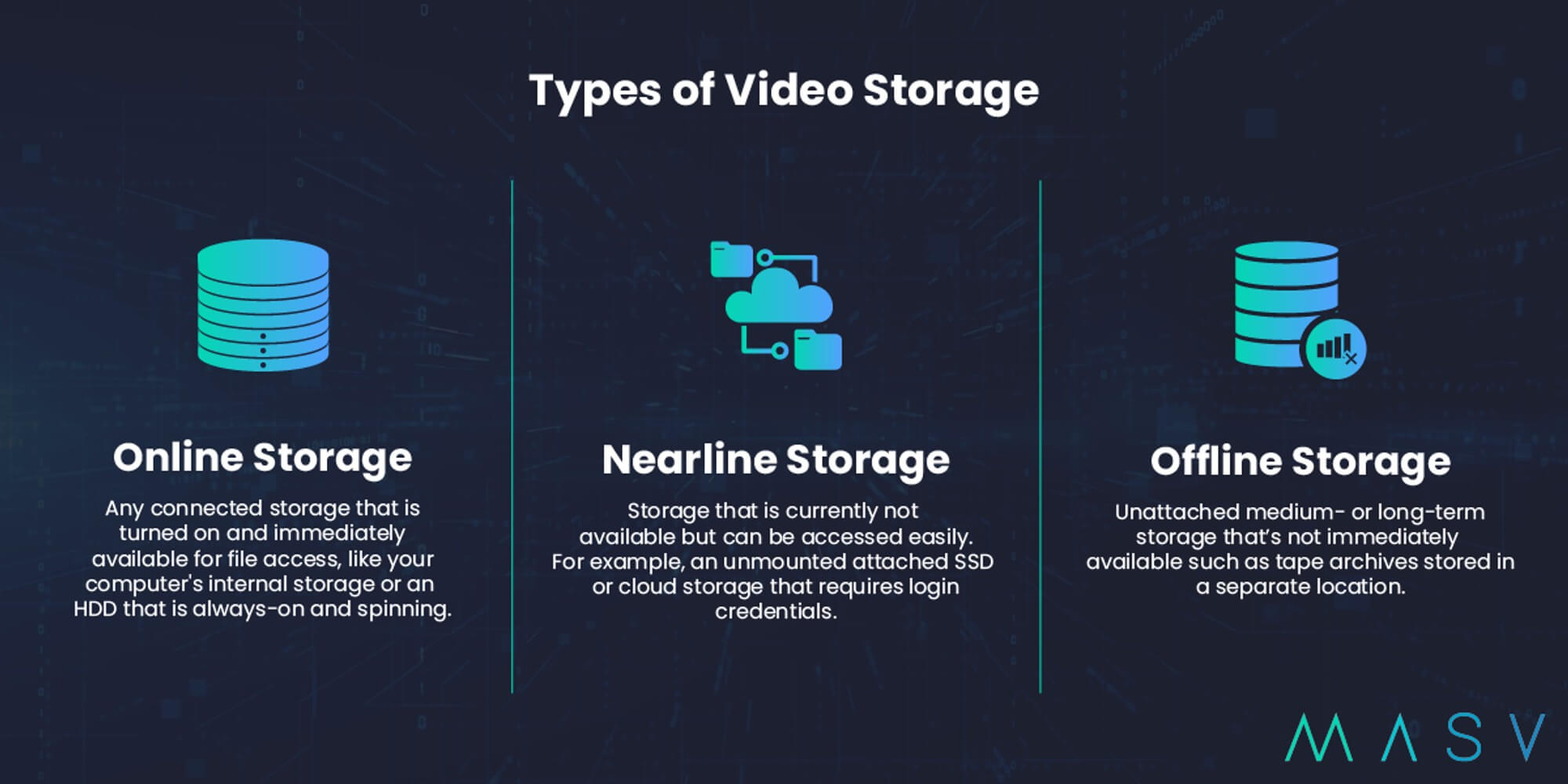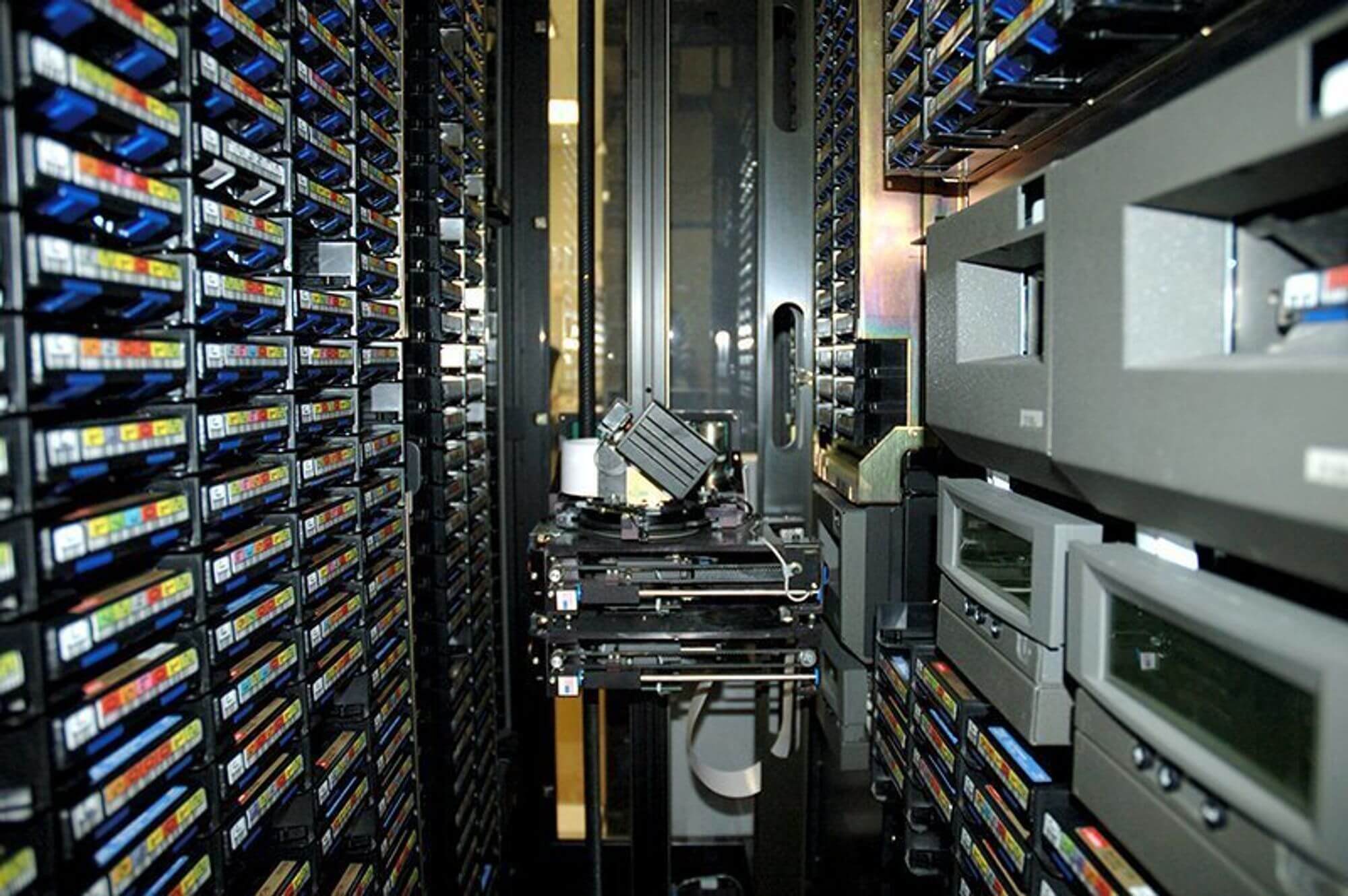Cloud storage. Local storage. Backup storage. Archive storage. Network attached storage. Cold storage.
Plenty of different terms exist when describing the array of digital storage options available. But all storage options and technologies for video production fall under one of three basic categories: Online storage, nearline storage, or offline storage.
So what is online storage vs. nearline storage vs. offline storage, and what are they good for? We break it down below.
Table of Contents
Have Big Files? Send Them With MASV
Use MASV to share up to 15 TB per file entirely online. Get started today in seconds.
What are Online Storage, Nearline Storage, and Offline Storage?
These three main types of storage for video and post-production work can be described in the following way:

What is Online Storage?
Any connected storage that is turned on and immediately available for file access, like your computer’s internal storage or an HDD that is always-on and spinning.
Note: Despite its name, most online storage is not connected to the internet! Online storage types can include:
- Network attached storage (NAS)
- Direct attached storage (DAS)
- Solid-state drives (SSD)
- Redundant array of inexpensive disks (RAID)
Online storage is usually on-site physical storage but can also include low-latency cloud storage.

Photo by Samsung Memory on Unsplash
What is Nearline Storage?
Storage that is currently not accessible but can be accessed easily. For example, an unmounted attached SSD or cloud storage that requires login credentials.
Nearline storage includes external HDDs, SSDs, or cloud storage such as Google Cloud Nearline Storage. Another, perhaps less common, example of nearline storage would be a robotic autoloader that can load cartridges on demand within a physical tape library.

Automated tape library – Tech Target
What is Offline Storage?
Unattached medium- or long-term storage that’s not immediately available such as tape archives stored in a separate location.
Most offline storage is portable, such as a USB stick, external HDD, or Linear Tape-Open (LTO) tapes stored offsite. Also known as archive storage.
Note: Despite its name, not all offline storage systems are disconnected from the internet! Examples of connected offline storage include rarely accessed cloud archive storage repositories such as Azure Archive Storage, Amazon S3 Glacier storage, or Google Cloud Archive Storage. Also known as “cold storage” in the cloud, cloud archive storage is cheap but sometimes can take hours or even days to retrieve data.
How Do I Determine What is Online, Nearline, and Offline?
You may be wondering how a storage unit — such as an HDD – can be classified as online, nearline, or offline. How do you determine which storage type falls into each category?
It’s important to remember that online storage vs. nearline storage vs. offline storage is less about hardware and more about setup and workflow. Each of the three storage types can share the same hardware; the storage type is defined by how it is used in a workflow.
For example:
- An always-on and super-fast HDD can be considered as online storage. Since this HDD is attached, turned on, and spinning, you can access files from it instantly.
- A grouping of slower HDDs that spin up and down automatically — also known as a massive array of idle disks (MAID) — is considered nearline storage. This is because MAIDs are designed to conserve energy and spin down when not in use.
- And an HDD stored offsite that needs to be located and loaded manually is classified as offline storage. In this case, the files are not accessible without significant effort.
Clear as mud yet? Good. Let’s move on to the advantages and disadvantages of each type.
Fast, Secure File Transfer for Media Workflows
Keep your production running smoothly. Use MASV to keep your large media files moving.
Advantages and Disadvantages
Each of these three storage types has its place in a larger workflow, and all three are part of the 3-2-1 data backup strategy. Each has advantages and disadvantages depending on the use case.
| Storage Type | Advantage | Disadvantage |
| Online storage |
|
|
| Nearline storage |
|
|
| Offline storage |
|
|
💡 Related: NAS vs. RAID Storage Differences
Data Accessibility and Data Durability
So what should you expect from online storage, nearline storage, and offline storage regarding data accessibility and data durability?
Online Storage
Accessibility
As we’ve recounted above, online storage is far and away the most accessible form of data storage. That’s because it’s always-on, highly available, and must be able to read and write data quickly and efficiently. If you need data to be available quickly and you often work with big files in real-time, online storage is the type of storage you want.
Durability
Online storage is undoubtedly the fastest but, in many cases, the least durable of the three storage types, often because it consists of always-on physical drives that can and do fail from overuse (SSD failure rates hover at around 1.05% and HDDs at 1.83%). A big part of the appeal of a RAID array as online storage is its redundancy and failover capabilities.
Data durability is less of an issue with even the highest-performing cloud storage, which in general guarantees high uptime and durability among all storage classes. All Google Cloud Storage options, for example, are designed for 99.999999999 percent durability.
But backups and archiving are an integral part of any storage workflow, which is why nearline and offline storage are equally important cogs in the storage wheel.
Nearline Storage
Accessibility
Nearline storage provides intermediate data accessibility and is essentially a hybrid of online and offline storage. Nearline storage must be somewhat available and performant for users who need to access the data occasionally. But it doesn’t need the specs required of storage solutions accessed multiple times a day, nor can it tolerate the slow data crawl offered by many archive solutions.
Durability
The same data durability issues arise with nearline storage as with online storage, with the huge caveat being that nearline drives are only spun up on demand — resulting in far less wear and tear. Cloud nearline storage is just as durable as cloud online storage.
Some external hard drive manufacturers market so-called nearline HDDs, which are slower hard drives the manufacturers say are more reliable than standard HDDs and can be operated around the clock.

Offline Storage
Accessibility
Offline archive storage, a mainstay in most disaster recovery plans, isn’t very accessible. However, that is not the use case of an offline storage. Offline storage is meant as a long-term storage solution.
Durability
Usually the most durable type of physical storage — especially when LTO tapes are involved, which are very durable and far less susceptible to mechanical failure than HDDs.
LTO tapes can last up to 30 years, compared to just a handful of years for the average HDD. Just keep in mind that tapes require ideal storage conditions to last that long, typically a consistent temperature of around 70 degrees with 40 percent relative humidity.
Always Have an Extra Failsafe
MASV stores all files transferred for seven days free, no matter the size.
Use Cases
- Online storage is best suited for video editing and other real-time data operations thanks to its high availability and low latency. Some types of online storage are faster than others, of course: SSDs can be up to 30 times faster than a standard hard disk drive (HDD).
- Nearline storage is a compromise between online and offline storage. Because it offers slightly lower availability and speed, as well as lower storage cost, it’s best suited for data of lower importance that may need to be accessed infrequently.
- Offline storage is best suited for archives and backups of infrequently accessed data.
Emerging Data Storage Technologies
Data storage has changed a great deal since IBM debuted its 350 disk storage unit (which featured 50 24-inch disks and could store around 5MB of data) in 1956.
Many emerging data storage technologies have come online in recent years, some of which are applied to traditional storage hardware such as HDDs or SSDs for better performance and reliability. These technologies include:
- Hyper-converged infrastructure (HCI): Server-centric, distributed shared storage. A storage architecture that can scale easily.
- Nonvolatile memory express (NVMe) storage interface: A data storage protocol that uses peripheral component interconnect express (PCIe) bus architectures and flash storage. Extremely fast storage used in flash drives and SSDs.
- Storage class memory (SCM): Storage that combines dynamic random access memory (DRAM) and NAND flash memory, and that does not require power to retain data. Features better durability than DRAM and up to a 10x performance boost over NAND drives.
- Edge storage: Data storage within internet of things (IoT) and endpoint devices, such as remote servers and computers. Data in edge storage is usually transferred to physical or cloud storage.
- Computational storage: Also known as in-situ processing, relies on data residing physically close to where it is processed for faster performance. Computational storage systems rely on fast SSDs and typically also include processors to run applications against the data.
Easily Transfer and Store Large Video Files
Secure, reliable, and fast transfer and storage of massive 8K or 12K video files with MASV.
The Best Storage Option for Video Workflows
When considering online storage vs. nearline storage vs. offline storage, it’s not a matter of choosing one over the other. Instead, it’s about finding the right combination of all three to fit into your video workflow.
- Online storage provides fast and immediate access to data, making it the option with the highest storage cost.
- Nearline storage is a great low cost option when you need to store files for an extended period of time without having to access them every day, but still frequently enough.
- Offline storage is best suited for backups in case of an emergency, or for archival data that is hardly ever accessed.
And when you need to move all that data, MASV is the best large file transfer service available today for video professionals.
MASV is a large file transfer tool built for filmmakers who need to transfer and ingest large media files — up to 15 TB per file, entirely over the cloud. You can transfer files to individuals or any major cloud storage provider with our direct-to-storage cloud integrations.
As an added bonus, we save all files transferred — regardless of their size — onto our own secure cloud server for five to seven days free depending on your plan as an extra redundancy. Those few days can turn into long-term storage for an added fee of $0.10 per GB/month.
In other words, MASV storage can be used as a nearline and offline form of storage for all your video projects.
MASV’s lightning-fast upload and download speeds allow remote production teams to access and begin working with large files in the cloud almost instantly, allowing teams to access files from anywhere while preserving file and folder structures.
Get started with MASV. It’s free to use; you get 10 GB free every month. After that, it’s Pay As You Go per transfer for flexibility, or opt for low-cost subscriptions for significant savings.
MASV File Transfer
MASV is free to use; you get 10 GB free every month.
